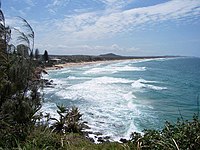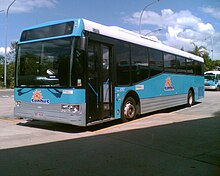Sunshine Coast, Queensland
| Sunshine Coast Queensland | |
|---|---|
 Maroochydore – Pusat Usaha, Perdagangan, dan Eceran di Sunshine Coast | |
| Jumlah penduduk | 251,081 (2010)[1] (10th) |
| • Kepadatan | 543/km2 (1.410/sq mi) |
| Luas | 462,4 km2 (178,5 sq mi) |
| Letak | 100 km (62 mi) dari Brisbane |
| Daerah pemilihan negara bagian | Buderim, Caloundra, Glass House, Kawana, Maroochydore, Nicklin, Noosa |
| Divisi Federal | Fairfax, Fisher, Wide Bay |
The Sunshine Coast is an urban area in South East Queensland, north of the state capital of Brisbane on the Pacific Ocean coastline. Although it does not have a central business district, by population it ranks as the 10th largest metropolis in Australia and the third largest in Queensland.
Sejarah
The Glass House Mountains, located south-west of Caloundra, were first sighted by James Cook from the deck of HM Bark Endeavour in 1770.[2]
In the 1820s, the Sunshine Coast saw its first white inhabitants: three castaways (Finnegan, Pamphlet and Parsons) who shared the life of the local (Kabi Kabi) Aborigines for eight months. Thereafter, during the 1830s to 1840s, the district became home to numerous runaway convicts, being only slightly north of Moreton Bay (Brisbane) penal colony.[3]
In 1841, Governor Gibbs had the entire Sunshine Coast and hinterland from Mt Beerwah north to roughly Eumundi declared a 'Bunya Bunya Reserve' for the protection of the bunya tree, having been advised of the Aboriginal importance of bunya groves by Andrew Petrie. However, during the 1840s and 1850s, the Bunya Bunya Reserve and its vicinity became the scene of some of the most bitter skirmishes of Australia's 'Black War.' The Blackall Ranges, on account of the tri-annual Bunya Festival, served as both a hideout and rallying point for attacks against white settlement. By the 1850s, timber getters and cattlemen were exploiting the area and in 1860, the Bunya Bunya Reserve was scrapped.
Many of the Sunshine Coast's towns began as simple ports or jetties for the timber industry during the 1860s and 1870s, as the area once had magnificent stands of forest. Likewise, the region's roads often began as snigging tracks for hauling timber. Timbergetters used the region's creeks, rivers and lakes as seaways to float out their logs of cedar – the resultant wood being shipped as far afield as Europe.
With the advent of the Gympie Gold Rush, prospectors scaled the Sunshine Coast mountains to develop easier roadways to and from the gold fields of Gympie. After construction of the railway line to Gympie, the coastal and river towns, being mostly ports for the early river trade, were bypassed.[4]
By the 1890s, diverse small farming (fruit and dairy) replaced the cattle-and-timber economy of earlier decades. Sugar cane and pineapples proved especially important produce for the district. Many small hamlets and towns now emerged. Produce was initially taken by horse to Landsborough, then to Eudlo in 1891[5]
Especially after World War II, the Sunshine Coast grew into a favoured holiday and surfing destination. This tendency was further expanded in the development boom of the 1960s and 1970s.[6] Around the same time, various tourist/ theme parks were created – the most iconic being Woombye's 'Big Pineapple.' During the 1960s and 1970s, the Sunshine Coast also attracted persons drawn to Alternative lifestyles. These newcomers developed a range of craft industries, co-operatives and spiritual centres, particularly in the hinterlands.
After the 1980s, the Sunshine Coast experienced rapid population growth. It is now one of the fastest-growing regions in Australia. As the region becomes increasingly residential, most of the district's distinctive small farms – especially tropical fruit farms – have disappeared, as have most of its theme parks. Instead, businesses concerned with retail, catering and tourism have assumed increasing importance.
Bisnis

The Sunshine Coast economy is currently dominated by three main sectors – tourism, retail and construction. The region also has a strong agricultural sector. Strong efforts are being made to diversify the regional economy by the Sunshine Coast Regional Council and others with an emphasis on 'clean and green' knowledge-based businesses across sectors such as information and communication technologies, cleantech, creative industries, aviation, education and food and beverages.
The Sunshine Coast is also emerging as a hotspot for entrepreneurial and innovative businesses. This has been partly fuelled by a new wave of around 80 start-up businesses – mainly in ICT, cleantech and creative industry sectors – generated by the University of the Sunshine Coast's Innovation Centre. The University site at Sippy Downs is designated as a 'Knowledge Hub' as part of the Queensland Government's South East Queensland Regional Infrastructure Plan and is master planned as Australia's first university town based on the UK models with the potential for over 6,000 workers in knowledge based businesses.[7] Sippy Downs was highlighted as an 'Innovation Hotspot' in July 2010 by top European Business magazine CNBC Business with the potential to be 'Australia's no-worries-answer to Silicon Valley'.[8]
Tata kota
There are many localities within the Sunshine Coast region, including the former Local Government Areas of Maroochy Shire, the Noosa Shire and the City of Caloundra. List of Locations Sunshine Coast

Pantai
Several stretches of the Sunshine Coast are lined with unbroken beaches – from Sunshine Beach near Noosa to Coolum Beach (17 km (11 mi)); the coast from Point Arkwright to Mudjimba (11 km (6,8 mi)); the Maroochydore–Mooloolaba stretch (56 km (35 mi)); and from Buddina past the Caloundra CBD to Pelican Waters (22 km (14 mi)). Notable beaches include:
- Noosa Main Beach
- Coolum
- Maroochydore
- Alexandra Headland
- Mooloolaba (the spit)
- Kawana Waters.
- Kings Beach in Caloundra
Pariwisata
The Sunshine Coast is a centre for tourism, containing attractions such as Steve Irwin's Australia Zoo, UnderWater World marine park, Aussie World with the Ettamogah Pub, The Buderim Ginger Factory, The Big Pineapple and the Majestic Theatre at Pomona.

Taman nasional
The Sunshine Coast region is home to more individual national parks than any other region in Queensland.[9] The natural biodiversity of the area has been protected by five separate parks in both coastal and inland regions, including Mapleton Falls National Park, Kondalilla National Park, The Glasshouse Mountains National Park, Noosa National Park, and the Great Sandy National Park, which includes sections on Fraser Island and in Cooloola near Rainbow Beach.
Lapangan golf
The Sunshine Coast has numerous golf links, including Headland Golf Club (Buderim), Pelican Waters, Pacific Harbour, Noosa Springs, Peregian Springs, Twin Waters, Hyatt Regency Coolum, Mount Coolum, Beerwah, Cooroy, Caloundra and Horton Park.
Infrastruktur
Pendidikan
The Sunshine Coast's educational infrastructure includes:
- Universities – The major university campus is the University of the Sunshine Coast at Sippy Downs, with Central Queensland University having a small campus based in Noosa.
- TAFE – There are five campuses at Caloundra, Mooloolaba, Maroochydore, Nambour & Noosa.
- Schools – The Sunshine Coast has many varied denomination, private and public primary and secondary schools.
Kesehatan
Nambour Hospital is the region's major hospital and attended to over 35,000 cases in 2005.[10] There are smaller hospitals located in Caloundra and Maleny, but due to limited facilities at those hospitals, most cases are referred to Nambour Hospital, thus leading to overcrowding and under-staffing at Nambour Hospital.[butuh rujukan]
A number of private hospitals exist throughout the region, most notably the 'Sunshine Coast Private Hospital' at Buderim, Caloundra Private Hospital (formerly known as Andrea Ahern) at Caloundra, Selangor Hospital at Nambour, the recently established Kawana Private Hospital, and smaller facilities at Noosa.
Queensland Ex Health Minister Paul Lucas initially proposed for a new public hospital to be constructed in the area of Kawana, to be called the Sunshine Coast University Hospital, by 2014. However, the projected completion date has now been extended to 2016.[11]
Transportasi
Jalan
The car is the predominant mode of transport for Sunshine Coast residents, with the region connected to Brisbane via the Bruce Highway. The Nicklin Way & Sunshine Motorway are the major arterial roads, which pass through most major areas of the Sunshine Coast. Many intercity and interstate coach operators also operate daily bus services to Brisbane using the major corridors.
Transportasi umum

Plane
Flights from the Sunshine Coast depart from Sunshine Coast Airport, which is located 10 km north of Maroochydore, and fly direct to Sydney and Melbourne with Jetstar, Virgin Australia and Tiger Airways.
Rail
Queensland Rail Citytrain's Nambour and Gympie North railway line operate numerous interurban services daily, with most trains running express between Caboolture and Bowen Hills stations. The train lines run through the Sunshine Coast Hinterland, with buses connecting to the coastal strip. Further north of the Nambour station, the trains only run once or twice per day.
Bus
Bus services are operated by Sunbus, which operates under the TransLink public transport system. These buses connect the suburbs and localities within the Caloundra, Maroochydore and Noosa local government areas. Noosa Shire Council operates zero-fare bus services connecting Noosa Heads to surrounding suburbs and major park and ride stations during the peak summer holiday period.
Ferry
There is a public ferry that operates between Tewantin, Noosaville, Noosa Waters, Northside and Noosa Heads.
Media
The daily, local newspaper is Sunshine Coast Daily which is published by APN News & Media. Other local/community owned newspapers cover the suburbs of the coast.
Sunshine Coast is served by publicly owned television services (ABC TV), (SBS) Television and three commercial television stations (Seven Queensland, WIN Television and Southern Cross Ten), which are the regional affiliates of the Seven, Nine and Ten network stations in Brisbane. The Sunshine Coast is also in the television broadcast licence areas of Brisbane (metro), enabling most areas of the Sunshine Coast to receive the commercial Brisbane stations. Subscription television services Foxtel and Austar are also available.
The Sunshine Coast region is served by commercial, community and government radio stations. Commercial stations 91.9 Sea FM and 92.7 Mix FM are owned and operated by the Macquarie Southern Cross Media Network. Rival commercial operator Prime Television runs 91.1 Hot FM and Zinc96. Government owned ABC services the region with 90.3 ABC Coast FM and Triple J on 89.5 FM and ABC Classic FM on 88.7 FM. Many community access stations, as well as some Brisbane stations can also be received.
Referensi
- ^ "3218.0 – Regional Population Growth, Australia, 2009–10". Australian Bureau of Statistics. 31 March 2011. Diakses tanggal 11 June 2011.
- ^ "Glass House Mountains National Park". Queensland Government. Diakses tanggal 12 June 2011.
- ^ GHD (March 2005). "Department of Natural Resources and Mines and Maroochy Shire Council" (PDF). hlm. 17. Diakses tanggal 12 June 2011.
- ^ "Nambour – Sunshine Coast Regional Council". Diakses tanggal 12 June 2011.
- ^ "Buderim – Sunshine Coast Regional Council". Diakses tanggal 12 June 2011.
- ^ "CHIMS (Department of Environment and Resource Management) – Cotton Tree". Queensland Government. Diakses tanggal 12 June 2011.
- ^ Hoffman, Bill (26 June 2010). "$290m will give us 1000 workers". Sunshine Coast Daily. Diakses tanggal 9 July 2010.
- ^ "Skippy Down Queensland". CNBC Business. 2010. Diakses tanggal 9 July 2010.
- ^ Sunshine Coast Australia.com National Parks Section
- ^ Nambour Hospital Profile
- ^ Protest-group over-hospital-delay
Pranala luar
- Sunshine Coast Tourism – Official Website
- Sunshine Coast Tourism Board – Includes information on how to reach the Coast.
